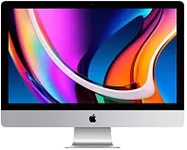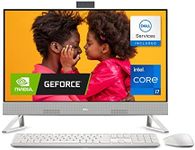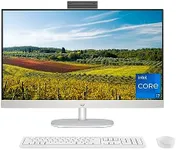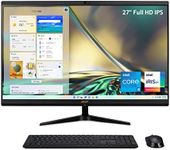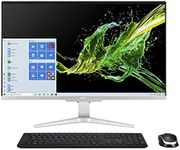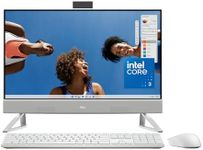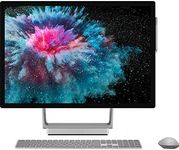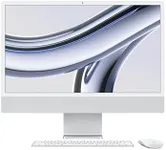Buying Guide for the Best All In One Pcs
All-in-one PCs are a great choice for those who want a streamlined, space-saving computer setup without the clutter of multiple components. These systems combine the monitor and the computer into a single unit, making them ideal for home offices, small workspaces, or anyone who values a clean and organized desk. When choosing an all-in-one PC, it's important to consider several key specifications to ensure you get the best fit for your needs.Display SizeThe display size of an all-in-one PC refers to the diagonal measurement of the screen. This spec is important because it affects your viewing experience and how much space the PC will take up on your desk. Display sizes typically range from 21 inches to 32 inches. Smaller screens (21-24 inches) are suitable for basic tasks and small spaces, while larger screens (27-32 inches) are better for multimedia, gaming, and multitasking. Choose a size that fits your workspace and meets your usage needs.
ResolutionResolution indicates the number of pixels on the screen, which affects the clarity and detail of the display. Common resolutions include Full HD (1920x1080), Quad HD (2560x1440), and 4K (3840x2160). Higher resolutions provide sharper images and are ideal for tasks like photo editing, video streaming, and gaming. If you primarily use your PC for browsing and office work, Full HD is sufficient. For more demanding visual tasks, consider Quad HD or 4K.
ProcessorThe processor, or CPU, is the brain of the computer and determines how fast and efficiently it can perform tasks. Processors range from basic models suitable for everyday tasks to high-performance models for intensive applications. Entry-level processors (e.g., Intel Core i3 or AMD Ryzen 3) are good for web browsing and office work. Mid-range processors (e.g., Intel Core i5 or AMD Ryzen 5) handle multitasking and moderate gaming. High-end processors (e.g., Intel Core i7/i9 or AMD Ryzen 7/9) are best for demanding tasks like video editing, gaming, and software development. Choose a processor based on the complexity of tasks you plan to perform.
RAMRAM (Random Access Memory) is crucial for multitasking and overall system performance. It allows your computer to run multiple applications simultaneously without slowing down. Common RAM sizes for all-in-one PCs range from 4GB to 32GB. For basic use like web browsing and office applications, 4GB to 8GB is sufficient. For more intensive tasks like gaming, video editing, or running multiple applications at once, 16GB or more is recommended. Consider your multitasking needs when choosing the amount of RAM.
StorageStorage refers to the amount of space available for your files, applications, and operating system. All-in-one PCs typically come with either HDD (Hard Disk Drive) or SSD (Solid State Drive) storage. HDDs offer larger capacities at lower prices but are slower. SSDs are faster and more reliable but can be more expensive. Storage sizes range from 256GB to 2TB or more. For general use, 256GB to 512GB is usually sufficient. If you store a lot of large files like videos or games, consider 1TB or more. Choose storage based on your data needs and preference for speed.
Graphics CardThe graphics card, or GPU, is responsible for rendering images and videos. Integrated graphics are built into the CPU and are suitable for basic tasks and light gaming. Dedicated graphics cards offer better performance for gaming, video editing, and other graphics-intensive applications. Entry-level GPUs are good for casual gaming and HD video playback. Mid-range GPUs handle more demanding games and applications. High-end GPUs are best for 4K gaming, professional video editing, and 3D rendering. Choose a GPU based on your need for visual performance.
Ports and ConnectivityPorts and connectivity options determine how you can connect peripherals and other devices to your all-in-one PC. Common ports include USB, HDMI, and Ethernet. USB ports are essential for connecting keyboards, mice, and external drives. HDMI ports allow you to connect additional monitors or TVs. Ethernet ports provide a stable wired internet connection. Additionally, consider wireless connectivity options like Wi-Fi and Bluetooth for convenience. Ensure the PC has enough ports and connectivity options to support your devices and usage habits.
Operating SystemThe operating system (OS) is the software that manages the hardware and software resources of the PC. Common operating systems for all-in-one PCs include Windows, macOS, and Chrome OS. Windows is versatile and supports a wide range of applications, making it suitable for most users. macOS is known for its smooth user experience and is preferred by creative professionals. Chrome OS is lightweight and ideal for web-based tasks and basic use. Choose an OS based on your familiarity and the type of applications you plan to use.
Design and Build QualityDesign and build quality affect the aesthetics and durability of the all-in-one PC. Look for a design that complements your workspace and personal style. Build quality is important for longevity and reliability. Consider factors like the materials used, the sturdiness of the stand, and the overall finish. A well-designed and solidly built PC will not only look good but also withstand daily use. Choose a design that you find appealing and a build quality that ensures durability.


